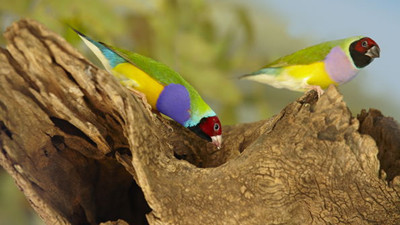Sexual selection and evolution
性選擇與進化
My pretty maid
美麗的雌性
A glamorous raiment sometimes helps a female bird as much as it helps a male
華麗的外表有時給雌性的益處和雄性一樣多
HOW the peacock got his tail is one of natural history's “Just So” stories that biologists like to think they have cracked. His tail is for showing off to the ladies just how fit he and his genes are. A less-than-perfect tail means no offspring. Genes for spectacular male tails are thus preserved and promoted over the generations in a process that is called sexual selection.
孔雀是如何得到它的尾巴,生物學家樂意認為這是他們已經破解的自然界奧秘故事之一。它的尾巴是向雌性炫耀它和它的基因是多么優秀。稍有瑕疵的尾巴意味著沒有后代。受世代性選擇的過程的影響,雄性華麗的尾巴的基因因此得到保留并進化。

There is, though, a problem with this story. Peahens, though not as showy as cocks, are by no means dowdy. Their heads have fetching crests, and their necks are a beautiful, iridescent blue. Such flummery is costly to grow and likely to attract predators. If you do not have to strut your stuff to get a mate, why do you need it?
然而,這個故事有一個疑問。雌孔雀雖不如雄性那樣艷麗,但也絕不俗氣。它們頭上有迷人的羽冠,以及光澤艷麗的藍色脖子。這種裝飾物會威脅生存,可能招致天敵。如果你不是為了求偶炫耀,那你為什么需要它?
Even more confusingly, in many species both sexes are equally showy—the Gouldian finches overleaf, for example (the female is on the right). So, though no one thinks the theory is incorrect, as far as it goes, it clearly does not go far enough. To understand things better James Dale of Massey University, in Auckland, New Zealand, and his colleagues have therefore examined the plumage of both sexes of all 5,983 species of passerine bird (peafowl, not being passerines, are not among them), and compared them in exquisite detail.
更不解的是,許多物種雄性和雌性都絢麗——例如上圖的彩虹鳥(右為雌性)。雖然沒人認為這個理論是錯的,但就現狀而言,顯然不夠正確。為了了解更多,新西蘭奧克蘭區梅西大學的詹姆斯戴爾,和同事調查了總共5,983種雀形目鳥類雌雄的羽毛,并比較了他們的細微細節(孔雀不是雀形目,不在調查之中)。
First, the team had to devise a way to deal with the 11,966 types of plumage they had set out to examine. Using the “Handbook of the Birds of the World”, regarded by ornithologists as the definitive work in the field, they picked six points on a bird's body (nape, crown, forehead, throat, upper breast and lower breast) and performed a spectral analysis of each to measure how red, green and blue it was. The average let them plot each plumage as a dot on a graph with three axes—red, green and blue.
首先,團隊設計了處理將要調查的11,966種羽毛的方法。用《全世界鳥類手冊》——被鳥類學家視為該領域最為完整可靠的資料,他們在鳥身上挑了6處(頸部,羽冠,前額,喉嚨,前胸和下胸),然后用光譜分析來測量紅色,綠色和藍色。在紅綠藍三維坐標系上用小點繪制了平均羽毛顏色的散點圖。
To translate this into a “showiness” score, the researchers started from the fact that, despite the exceptions, showiness is still more a male than a female phenomenon. They therefore calculated, as a proxy for showiness, a “maleness” score for each dot, regardless of which sex it represented, by counting the sexes of its nearest 120 neighbours in the graph (ie, the nearest 1% of dots). They then ran these scores against characteristics, such as the size of a species, its habitat and its pattern of family life.
為了轉化成“絢麗”分數,研究者從事實發現:除了個別例外,炫耀現象雄性多余雌性。因此他們計算出每一“雄性”點得分:無論雌性還是雄性有絢麗的裝飾物,通過計算它附近120個兩性點(將近1%的點)。然后將這些分數對比特征,比如物種的大小,棲息地以及生活習性。
Their first observation, as they report this week in Nature, was that in species where a few males monopolise all the females, with a consequent lack of male involvement in parental care, males were more colourful than females. This is what the theory of sexual selection would predict. What it would not predict in its simple form, though, was a second finding—that females in co-operatively breeding species (those in which, for lack of other opportunities, several females collaborate to raise the young of only one of them) are more ornamented than those in which all adult females have a chance of breeding. In this case it is females who are competing for the right to reproduce, thus putting themselves in a more male-like position.
他們第一次觀察報告結果出版在本周《自然》上:在少量雄性配對所有雌性的物種,在親代撫育中缺少雄性角色的緣故,雄性比雌性更艷麗。這是性選擇理論做出的預測。然而,這個簡單形式的理論不能預測的是第二個發現:在合作哺育的物種(缺少雄性情況下,幾個雌性合作只能撫養其中一個后代),雌性比有機會和雄性一起繁殖后代的雌性更花哨。這個例子中正是雌性完成了繁殖的任務,因此他們扮演了雄性的角色。
Another widespread belief Dr Dale and his colleagues confirmed is that tropical species are more colourful than those from temperate climes. But again, there was a twist—the effect was much more marked in females than in males. Something about the tropics favours colourful females. It may be that tropical birds, which face more intense competition for food and nesting sites than temperate ones do because the tropics have more species, form more stable and collaborative pair-bonds than do temperate birds. In these circumstances males also need to be choosy, and females competitive. Selection for gaudy plumage therefore works in both directions.
戴爾博士和同事證實的另一個普遍的觀點是,熱帶氣候里的物種比溫帶的更鮮艷。但有一點不同——這種效果雌性比雄性表現得更明顯。熱帶環境偏愛外表鮮艷的雌性。這可能是熱帶鳥類形成了更穩定更協作的一夫一妻制,因為熱帶有更多物種,熱帶鳥類比溫帶鳥類存在更激烈的食物競爭和巢穴競爭。這種環境下雄性挑選配偶,而雌性去競爭。因此絢麗羽毛在自然選擇上往兩個方向發展。
The final effect the researchers found was that big species are more colourful than small ones. That is true of both sexes, and probably reflects the fact that bigger birds are more difficult prey and thus have less need to hide. When released from the threat of predation, then, females tend to be gaudier. That suggests gaudiness is always good when it can be got away with (for even in a promiscuous species, pretty females are likely to be at an advantage to ugly ones)—and probably explains the decorated necks and heads of peahens, which are among the biggest of birds.
研究人員發現的最后一個結果是,體型大的物種比體型小的更鮮艷。雌性和雄性都符合這點,也反映了大型鳥不容易被捕殺故而不必隱藏的事實。一旦沒有天敵的威脅,雌性就變得更花哨。這表明在沒有天敵威脅下,華麗點總是好的(即使在一個濫交的物種,漂亮的雌性比丑的可能更有優勢),也解釋了為何雌孔雀擁有艷麗的脖子和頭部,因為它是體型最大的鳥類。
Putting these results together, then, suggests that what is happening in the arena of sexual selection is as much to do with females as with males. Just as females are half the world, so the conventional explanation of the peacock's tail, though not wrong, is only half the story.
這些結果一起暗示了性選擇過程中雌性和雄性變化一樣多。就像雌性占世界的一半,孔雀尾巴的傳言雖然不是錯的,但只是故事的一半。譯者:大故事












